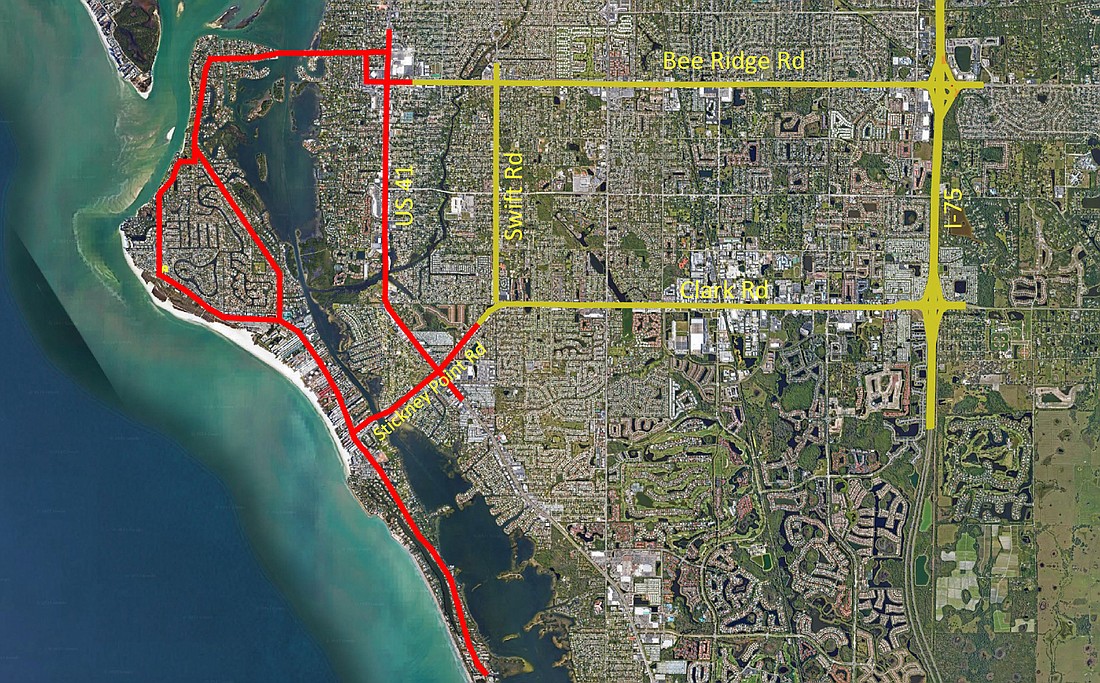- April 21, 2025
-
-
Loading

Loading

With developers continuing efforts to bring high-density hotels to Siesta Key, the Sarasota County Commission in April 2023 requested the staff prepare a report on developing a traffic model to include all modes of transportation on the island, including pedestrians.
The purpose was to create a benchmark of the unique traffic conditions on the barrier island as a regulatory tool for future development.
After hearing from Public Works Director Spencer Anderson about the estimated $500,000 cost for 18 months to develop the model plus ongoing update costs — for perhaps little detail beyond what is already known about traffic conditions — commissioners on Jan. 30 rejected the proposal 3-2 with Mark Smith and Joe Neunder in favor.
Both of their districts include portions of Siesta Key.
Because state statute does not permit concurrency requirements such as decreases in level of service to be used to deny a special exception rezoning outside a quarter-mile from the project address, staff’s direction was to define a measurable that could be used for regulating development.
“Because concurrency was repealed by the state, we can no longer look at things farther than a quarter-mile away from the development site,” Anderson told commissioners. “If we had a development at Stickney Point Road and Midnight Pass Road, and in the modeling effort it showed that development caused a problem at Beach Road, we couldn't make the developer do that improvement or deny that the development based on that impact.”
The micro-simulation model, Anderson said, would require a successful vendor to track all modes of transportation on the key’s primary streets, from trucks to scooters to pedestrians for a year, followed by perhaps another six months of modeling. To present an accurate study, the model would also need to factor in seasonal, offseason and special events traffic. The $500,000 cost, he said, is an educated guess. Costs of ongoing updates are unknown.
“I'm certainly not going to support moving forward on this for a lot of reasons, one of which is you thought this may cost a half a million dollars to begin with and then there's ongoing cost every year to maintain,” Commissioner Ron Cutsinger said. “What would be the advantage of doing something that's costly, with ongoing costs, when in fact it doesn't seem to me that there is that big of a benefit long term?”
Anderson agreed that the data that the modeling would produce would likely not be significantly more enlightening than the professional judgment and level of modeling staff can currently perform. Any additional benefits are theoretical.
“Theoretically, it will give us better information for regulatory purposes,” Anderson said. “No one in the country uses a micro-simulation model for regulatory purposes, so we would be on the leading edge of something that's not been done before. The theory is it would give us better information to make decisions.”
Smith argued that the unique traffic pattern of Siesta Key, and other narrow barrier islands, separates it from mainland traffic patterns that have available options for alternative routes to disperse traffic. Combined with only two drawbridges providing island ingress and egress, which when raised shut all traffic down in both directions, a deeper dive into modeling is essential for development consideration regardless of the cost.
He referenced last year’s Division of Administrative Hearings (DOAH) and 12th Judicial Circuit Court decisions that, in short, cited the constrained roads of Siesta Drive and Stickney Point Road — as defined by the county's Comprehensive Plan — as justification for rejecting two county-approved hotels on Siesta Key via special exception.
“From the DOAH, there are only two bridges that provide access and evacuation routes to the mainland from Siesta Key. Both of these bridges are designated as constrained roads by the comprehensive plan,” Smith said. “Therefore the county must base approvals on maintaining existing levels of service on constrained roads and to not allow existing conditions to degrade.
“And on the circuit court side, the greatest route constrictions in the county are the exit routes from the barrier islands to the mainland. We can't make the assumption that a future comprehensive plan change to intensify use on the barrier islands won't go without challenge, so I'm obviously a strong proponent of having this Siesta Key model go forward.”
Neunder supported moving the measure forward for the purpose of learning the cost of the modeling project, with that knowledge later deciding whether to invest in the study.